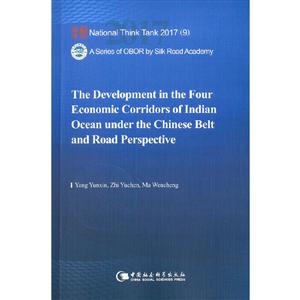-
>
中共中央在西柏坡
-
>
中国历代政治得失
-
>
中国共产党的一百年
-
>
在庆祝中国共产主义青年团成立100周年大会上的讲话
-
>
中国的民主
-
>
中华人民共和国六十年实录(套装共10册)
-
>
新书)社会主义发展简史(大字本)
“一带一路”视野下中国在印度洋四大经济走廊的发展:英文 版权信息
- ISBN:9787520303859
- 条形码:9787520303859 ; 978-7-5203-0385-9
- 装帧:平装-胶订
- 册数:暂无
- 重量:暂无
- 所属分类:>>
“一带一路”视野下中国在印度洋四大经济走廊的发展:英文 内容简介
随着“一带一路”六大经济走廊建设的推进和深入,沿线国家所存在的政治风险、投资风险、恐怖主义威胁以及地缘政治风险也越来越多地暴露出来,中亚和南亚成为困难*为集中的地区。本报告在系统分析中亚、南亚地缘政治热点基础上,提出了构建“大中亚经济圈”、“印度洋经济圈”和“孟加拉湾经济圈”的建议。
“一带一路”视野下中国在印度洋四大经济走廊的发展:英文 目录
“一带一路”视野下中国在印度洋四大经济走廊的发展:英文 作者简介
杨玉鑫,研究生毕业于马来西亚因萨尼亚大学阿拉伯语专业,曾在阿拉伯国家工作多年,曾担任阿尔及利亚北方建筑总公司首席阿拉伯语翻译,参与阿尔及尔一万套住宅等多项国家级项目的谈判。研究生期间参与国家社科项目的翻译工作。智宇琛,中国社会科学院西亚非洲研究所助理研究员。长期从事中资企业在非洲能矿合作开发、基础设施建设及制造业等领域发展研究,具有10年中央企业发展战略部门负责人工作经验,曾任中国铁路通信信号集团办公室副主任、研究设计院企业战略与法务部部长等职务。在此期间,多次主持编制企业发展战略规划,组织建立全面风险管理和内部控制体系。,马文琤,中国社会科学院西亚非洲研究所助理研究员,中国社会科学院“一带一路”研究中心特聘研究员,中国社会科学院上海研究院特聘研究员,中东学会阿拉伯项目部主任。目前主要从事中东政治、伊斯兰文化的理论与与研究工作。近年先后主持或参加多项国家社科基金、国家民委、中国社会科学院院级重点科研项目,参与多部《中东黄皮书·中东发展报告》的撰写,参写、参编著作、教材多部,发表各类研究成果100余万字。
- >
自卑与超越
自卑与超越
¥12.7¥39.8 - >
月亮与六便士
月亮与六便士
¥15.1¥42.0 - >
伯纳黛特,你要去哪(2021新版)
伯纳黛特,你要去哪(2021新版)
¥15.9¥49.8 - >
中国人在乌苏里边疆区:历史与人类学概述
中国人在乌苏里边疆区:历史与人类学概述
¥35.5¥48.0 - >
有舍有得是人生
有舍有得是人生
¥17.1¥45.0 - >
龙榆生:词曲概论/大家小书
龙榆生:词曲概论/大家小书
¥13.0¥24.0 - >
莉莉和章鱼
莉莉和章鱼
¥13.4¥42.0 - >
苦雨斋序跋文-周作人自编集
苦雨斋序跋文-周作人自编集
¥6.9¥16.0
-
1793乾隆英使靓见记(九品)
¥13.7¥39 -
改变历史的间谍-特工.线人和阴谋家如何书写历史
¥15.1¥39.8 -
较量背后的深思:中日儿童教育比较
¥6.5¥12 -
亚洲冷战史研究(九品)
¥21.9¥55 -
美国对华情报解密档案(1948-1976)(共8卷)
¥793.6¥1280 -
当代日韩关系研究1945-1965
¥25.9¥58



















